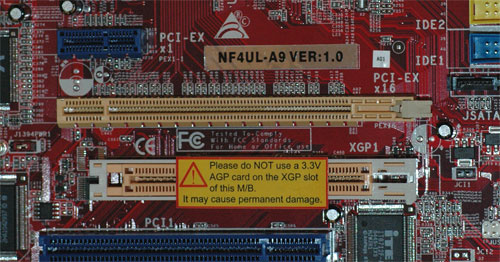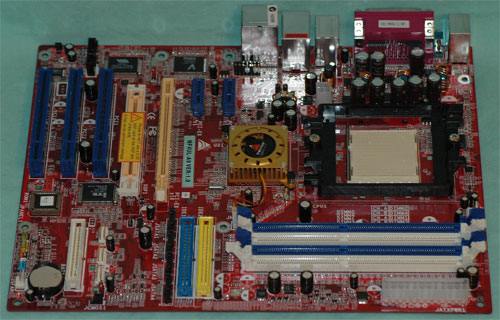nForce4 Ultra Roundup: Charting the Mainstream
by Wesley Fink on July 5, 2005 10:28 PM EST- Posted in
- Motherboards
Biostar NF4UL-A9: Features and Layout
| Specification | Biostar NF4UL-A9 |
| CPU Interface | Socket 939 Athlon 64 |
| Chipset | nForce4 Ultra (single chip) |
| BUS Speeds | 200MHz to 300MHz (in 1MHz increments) |
| PCI/AGP Speeds | Asynchronous (Fixed) |
| PCI Express | Fixed |
| Core Voltage | Startup, 1.2V to 1.625V in 0.025V increments |
| DRAM Voltage | Default, 2.7V, 2.8V, 2.9V |
| Chipset Voltage | NA |
| Hyper Transport Ratios | Auto, 1x, 2x, 3x, 4x, 5x |
| LDT Bus Transfer | 16/16, 16/8, 8/16, 8/8 |
| CPU Ratios | Startup, 4x to 25x in 1x increments |
| DRAM Speeds | Auto, 100, 133, 166, 200 |
| Memory Command Rate | Auto, 1T, 2T |
| Memory Slots | Four 184-pin DDR Dual-Channel Slots Unbuffered ECC or non-ECC Memory to 4GB Total |
| Expansion Slots | 1 x16 PCIe Slots 1 Xtreme Graphics Port (AGP 8X Form Factor) 2 x1 PCIe 3 PCI Slots |
| Onboard SATA | 4-Drive SATA 2 by nF4 |
| Onboard IDE | Two Standard NVIDIA ATA133/100/66 (4 drives) |
| SATA/IDE RAID | 4-Drive SATA 2 PLUS 4-Drive IDE (8 total) Can be combined in RAID 0, 1 |
| Onboard USB 2.0/IEEE-1394 | 10 USB 2.0 ports supported nF4 2 1394A FireWire ports by VIA VT6307 |
| Onboard LAN | Gigabit PCIe Ethernet by Vitesse VXC8201 PHY |
| Onboard Audio | Realtek ALC850 8-Channel codec with 6 UAJ audio jacks, CD-in, front audio, and optional coaxial SPDIF cable |
| Other Features | Dual-Core (x2) Support with BIOS nf4ua614 |
| BIOS | nf4ua614 |
Biostar took a different approach in the design of their nForce4 Ultra board. If you look closely at the video card slots, you will see how unique this board really is.

Even though it is not a full 8X AGP slot, the Biostar is still a unique and useful choice for those having AGP cards that they are not ready to replace. Those buyers can go to the Biostar with their current AGP card and still have the option of moving to PCIe on the same board at some time in the future. Since nForce4 does not support AGP, the Biostar allows AGP users to choose an nForce4 board anyway.
The Biostar is basically a sound board layout, particularly for a lower-priced nF4 motherboard. The 4-pin 12V power connector requires snaking the 4-pin power cable over or around the CPU, a design that many others also use. The board edge is a better location, and fortunately, the 24-pin ATX cable does reside on a board edge where it belongs. The 4 SATA connectors are a tight fit next to the PCIe slot, but they will work - even with a very long PCIe video card with dual power connectors.
The floppy connector is on the lower right edge of the board, which is certainly a better location than the bottom of the board, but still a longer reach than the preferred upper right location. Turning the IDE connectors sideways allows them to fit on the right edge near the center of the board. In most case designs, this will work fine, but a tall case with drives above the board chamber might require snaking IDE cables over DIMMs - not ideal for air flow.
BIOS controls on the Biostar were a pleasant surprise for an entry-level nForce4 Ultra motherboard. Just about every adjustment that you need for overclocking is here, including a useful vDIMM range to 2.9V, a wide CPU voltage adjustment range, and CPU ratio adjustments. The same goes for features, as our board even had dual Firewire ports controlled by a TI controller. Firewire is one of the first options to go when manufacturers build to a price point.
The only glaring omission is the lack of a standard SPDIF optical or coaxial out port. A board with 8-channel sound and 6 jacks should have a supplied SPDIF connector, not an optional feature.
We also ran into a very strange anomaly when benchmarking the XGP graphics slot. When we mounted an 8X AGP card and selected PCI as out boot video, the system booted just fine into Windows XP. However, the Gigabit LAN had mysteriously disappeared and no amount of searching for new devices would bring it back. We removed the AGP and reinstalled a PCIe video card and the Gigabit LAN was back. We hope that Biostar can find a way to correct this strange behavior in a future BIOS update.
Abit Fatal1ty AN8: Overclocking and Stress Testing
Biostar NF4UL-A9: Overclocking and Stress Testing











75 Comments
View All Comments
vijay333 - Wednesday, July 6, 2005 - link
oh...final system will have 4-5 HDs, standard DVD reader/writer along with (most likely) a 6800Ultra or a X800XL...Xenoterranos - Wednesday, July 6, 2005 - link
Anandtech did toy with a listening test a while back (I really don't remember much about it, other than the fact that they should have used Klipsch proMedia Ultra 5.1 speakers...)vijay333 - Wednesday, July 6, 2005 - link
Maybe I missed this info in the article somehow, but could you provide the minimum/recommended PSU wattages for the motherboards? esp the DFI and the Epox. I have a Antec 400W Smartpower PSU right now, but read a few posts on newegg that this might not be enough? Hope I don't need to upgrade this too along with the mobo, cpu and gpu...vijay333 - Wednesday, July 6, 2005 - link
knitecrow - Wednesday, July 6, 2005 - link
I have a comment about audio -- a topic that most sites ignore.Shouldn't there be a blind listening test?
i mean cpu utilization is fairly useless. If i am listening to mp3s i care more about the quality than cpu utilization.
flatblastard - Wednesday, July 6, 2005 - link
I stopped reading on page 4 upon discovering the round-up. No explanation needed...Wesley Fink - Wednesday, July 6, 2005 - link
g33k -The DFI was more a control to demonstrate SLI and Ultra performance were the same other than SLI video. Drivers have updated and we retested everything on the DFI as a sanity check. We ran benchmarks and not a full review, but it was hard to ignore the excellent performance.
There is also a comment in our Final Words that the MSI Ultra board should also be considered a winner, since the SLI version was a Gold Editors Choice in the SLI roundup, and the Ultra should perform the same.
g33k - Tuesday, July 5, 2005 - link
Along the same logic though, I'm curious as to why you chose to review the DFI Ultra-D when you reviewed the SLI version of this board earlier as well?.g33k - Tuesday, July 5, 2005 - link
Jeez, read Wesley's comments, he just answered why he did not review, the MSI board. It was already reviewed in the SLI roundup.Wesley Fink - Tuesday, July 5, 2005 - link
"As you can see, none of the onboard audio solutions were quite as low in CPU utilization as the Creative SoundBlaster Live! Chip, which is used on the MSI K8N Neo4 SLI Platinum tested in the nForce4 SLI roundup."Since this is still nF4 we included components tested on all nForce4 boards. The Ultra version of the MSI, BTW, uses the Realtek ALC850 chipset and not the Sound Blaster Live!. The SB Live! is only used on the MSI SLI.